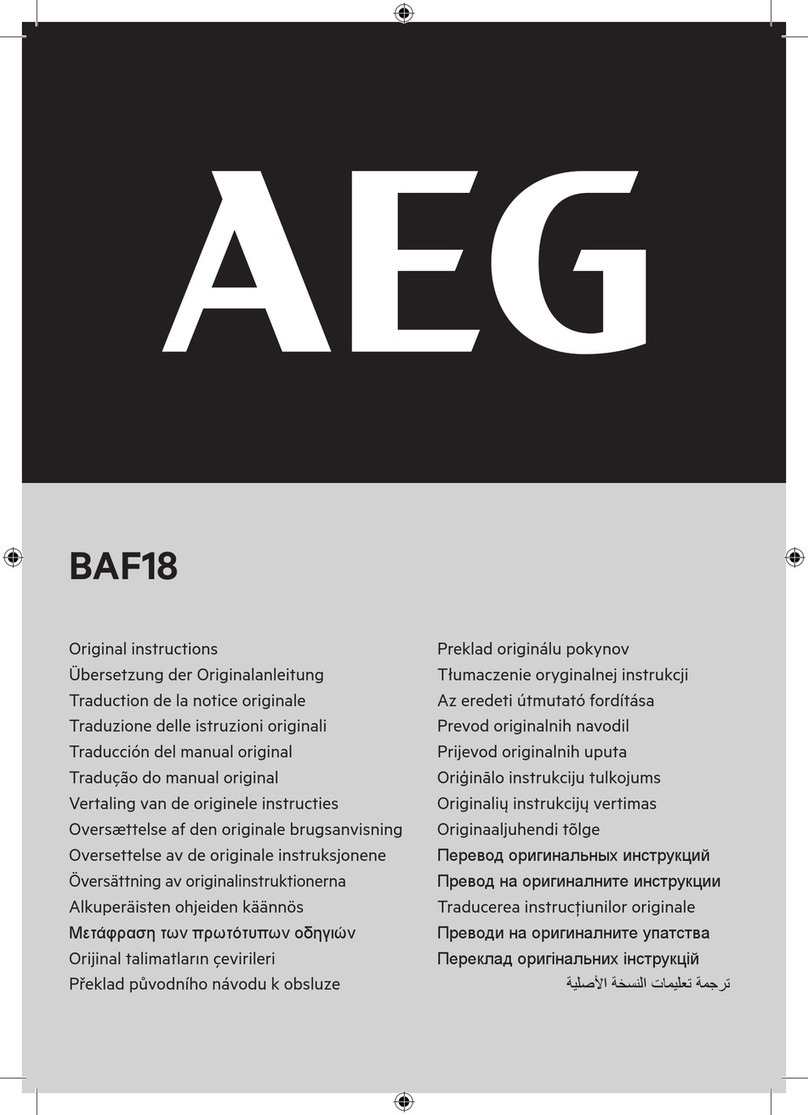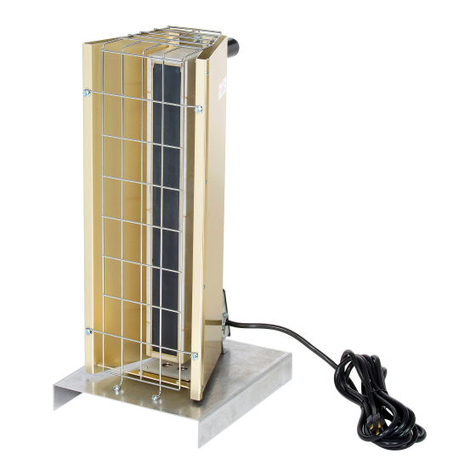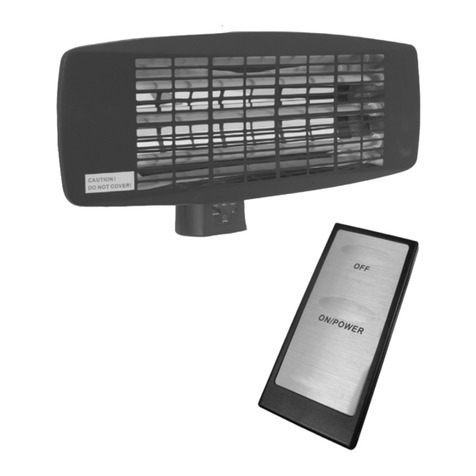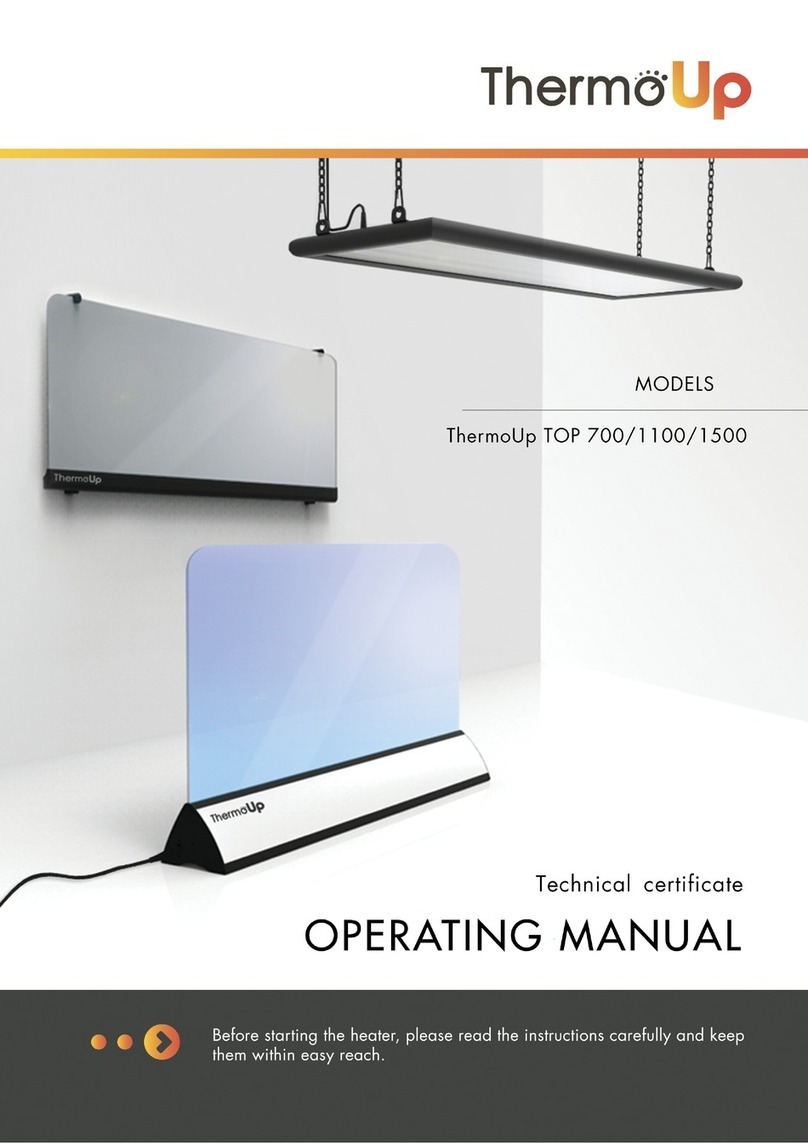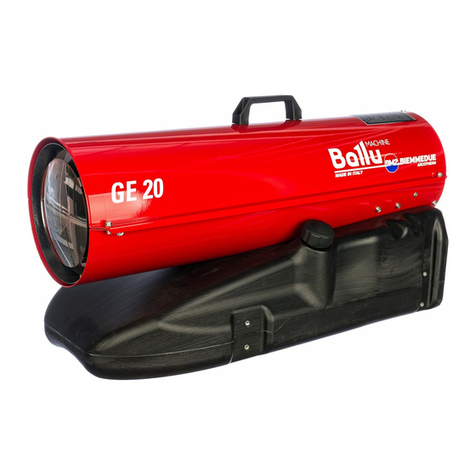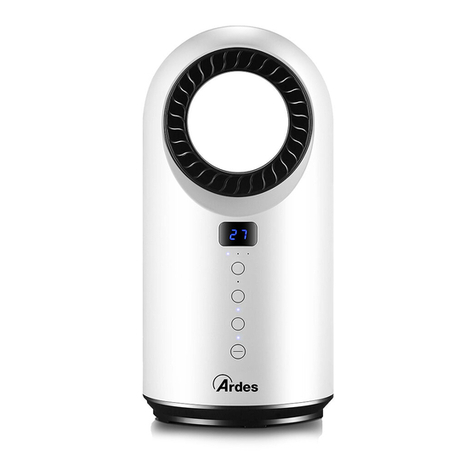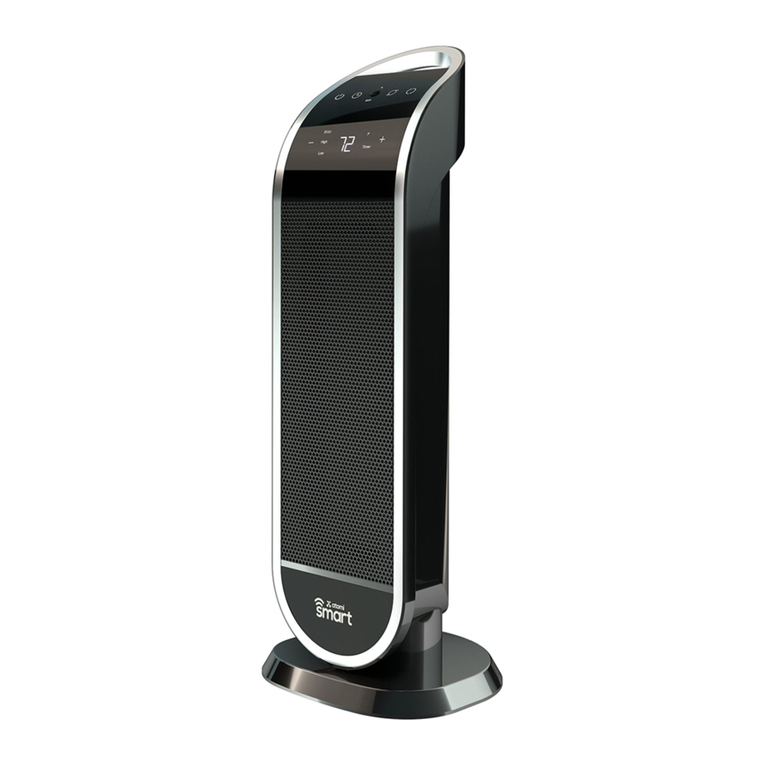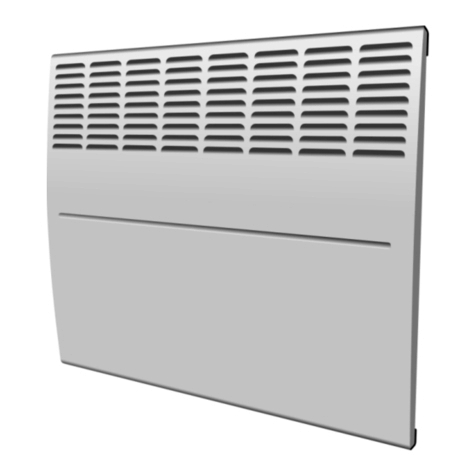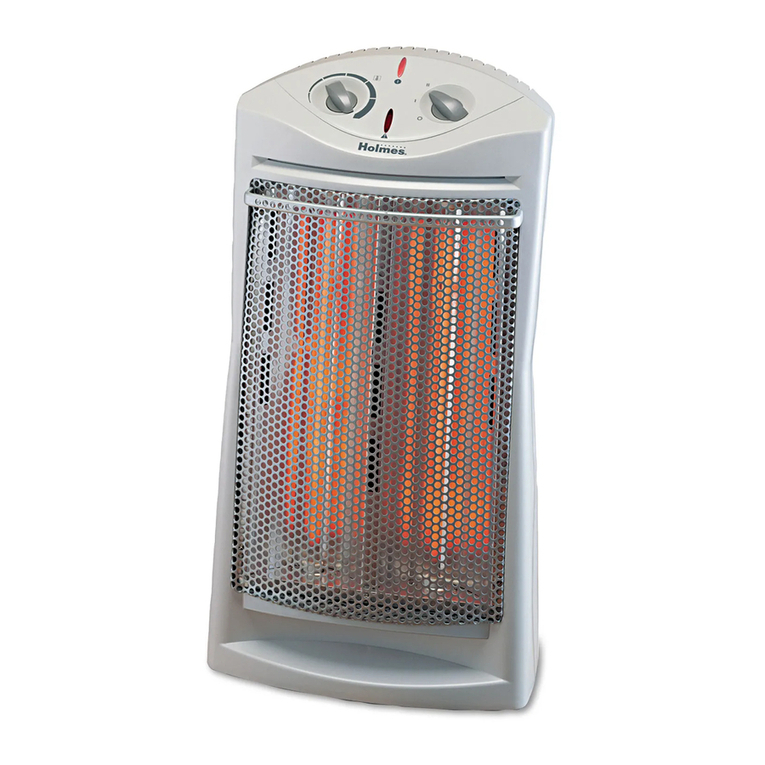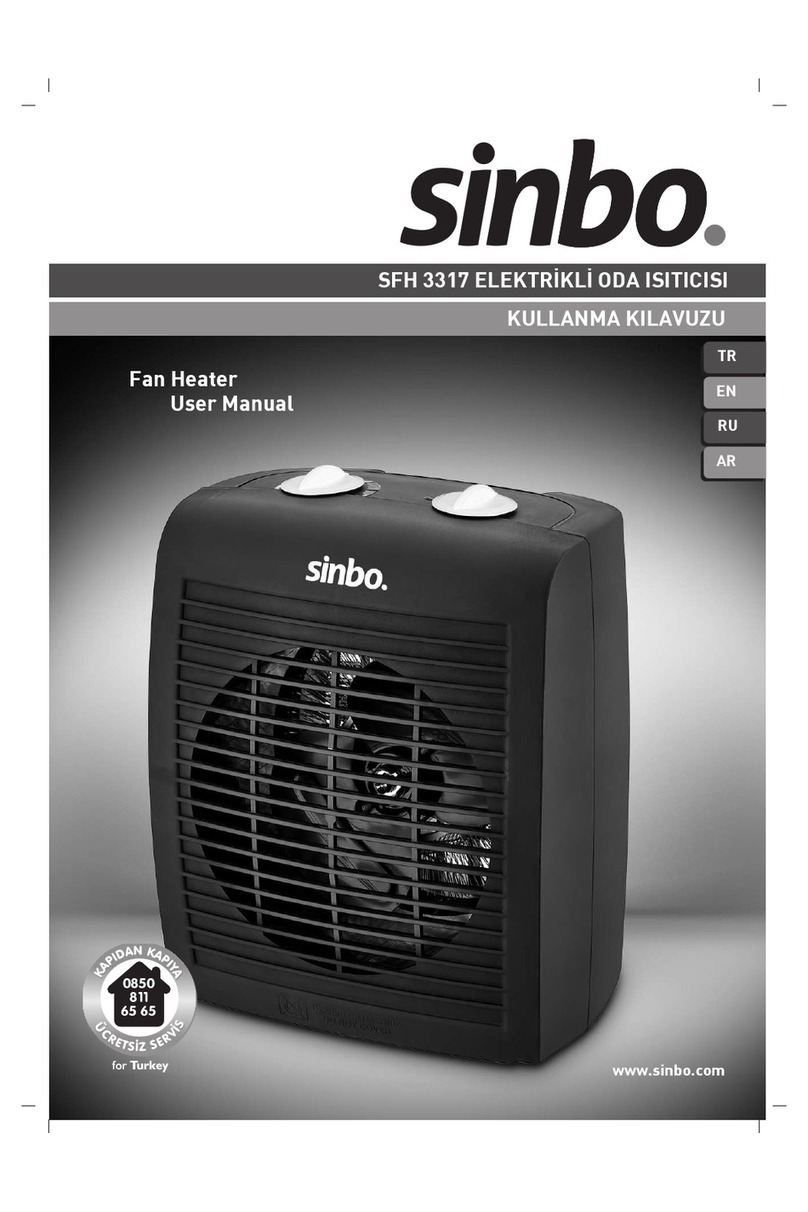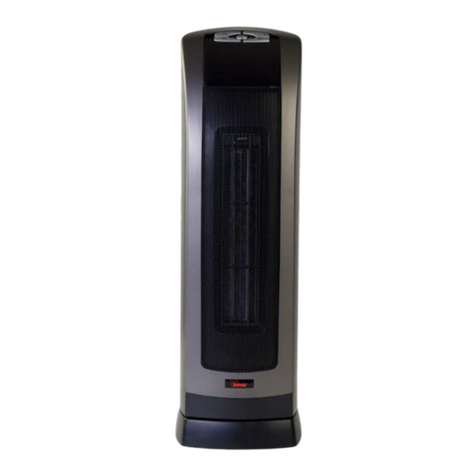Elston Manufacturing LC series User manual

Revision F
Updated 2011
Elston Manufacturing
LC Heater
Owners Manual


Table of Contents
Table of Contents
Safety Information.............................................................................................................ii
1) Introduction to Heater...................................................1
2) Operating Instructions..................................................4
2.1 Operating Precautions..................................................................................................4
2.2 Running the Heater or the irst Time or After the Unit Has Been Idle for a Long
Time...................................................................................................................................5
2.3 General Recommendations for Loading and Heating Cargo........................................6
2.4 Normal Operation........................................................................................................7
3) Service Instructions........................................................8
3.1 Every Time You Walk By the Heater.........................................................................8
3.2 Every Time the Trailer is Loaded and Unloaded.........................................................8
3.3 Annually Before the Start of the Winter Season .........................................................8
3.4 Every Three Years......................................................................................................9
4) Troubleshooting...........................................................10
Problem A: Nothing happens when I turn on the heater...................................................10
Problem B: The green indicator light comes on but the blower does not run...................11
Problem C: Blower runs but heater fails to ignite............................................................12
Problem D: Heater usually ignites but sometimes does not..............................................13
Problem E: Heater ran down the battery at night while plugged in..................................13
Problem : Carbon Deposits near Exhaust Outlet or Smoke from Exhaust Outlet...........13
) Installation....................................................................1
5.1 Overview....................................................................................................................15
5.2 Unpacking the Heater and Gathering Supplies...........................................................16
5.3 Heater Placement ......................................................................................................16
5.4 Mounting....................................................................................................................17
5.5 Wiring........................................................................................................................18
5.6 uel System................................................................................................................19
5.7 inal details................................................................................................................22
6) Repair............................................................................23
6.1 Performing a ull Adjustment of the Burner.............................................................23
6.2 Checking the Operating Voltage of the Heater..........................................................23
6.3 Checking that the Regulator is Producing the Correct Pressure................................24
6.4 Replacing Blower......................................................................................................24
6.5 Removing combustion chamber................................................................................24
7) Parts List for HLC Heaters.........................................27
Valid for models LC-1 and LC-110 beginning with serial number H2396
i

Safety Information
Safety Information
The heater you have purchased was designed, first of all, to be safe. However, since this
heater burns propane, safety precautions are necessary for the safe and reliable operation
of this product. or your safety, please take the time to read the appropriate sections of
this manual before installing, servicing, or operating the heater.
Use only propane vapor for fuel. Use this heater only with regulators
and tanks that provide propane vapor at 10.5 to 11 inches of water
column. Use of a different fuel, a liquid withdrawal cylinder, and/or
propane vapor at a significantly different pressure risks fire or
explosion.
Do Not Bypass or Remove Safety Equipment
Although we understand temporary measures must sometimes be made
to save a load, bypassing any safety device may result in fire or
explosion. or your safety, do not temporarily bypass any safety
equipment, and if you do, please fix these temporary measures as
quickly as possible.
Use only exact parts or manufacturer approved replacements for repair
or proper function and safety, critical parts such as hoses, regulators,
guards, and controls, must match the existing part.
Do not service heater until unit has cooled for at least 15 minutes
Heat exchanger and attached parts remain hot enough to cause burns
after unit is shut off until they have cooled for a few minutes.
Turn off power to the heater during service. Keep power off unless
necessary for testing as heater can start unexpectedly and could
pinch or cut fingers or sustain damage from tools.
Use only in accordance with local regulations. Current regulations in your
area may require that the installer of this heater or, more likely, that the
person servicing the propane fuel system meet certain requirements. If you
are unsure what is required, please refer to the current regulations in your
area or speak with the authority having jurisdiction before beginning
installation.
WARNING: During operation, the exhaust of this heater produces carbon monoxide, a
chemical known to the state of California to cause birth defects and/or other reproductive
harm.
As always, apply common sense and beware the perils of ignorance. If you’re not sure
it’s safe or don't have enough knowledge to know if it is safe, then don’t do it.
ii

Chapter 1 Introduction to Heater
Introduction to Heater
The LC heater you have purchased is a thermostatically controlled propane heater. It is
designed to be mounted on the nose of a trailer to heat cargo. However, it may be used in
similar situations where heat is needed.
It is a heavy duty forced air heater with electronic ignition. To maximize energy
efficiency, it heats air drawn from inside the trailer instead of heating up cold outside air.
The exhaust exits out of the bottom of the heater.
Specifications
Dimensions..............................................36 in wide x 16 in tall x 9 in deep
Weight..................................................................................................80 lbs
Shipping Weight..................................................................................82 lbs
Rating........................................................................................35,000 BTU
Cold Air Inlet Diameter...........................................................................6 in
Hot Air Outlet Diameter..........................................................................4 in
Hot Air low.................................................................150 cfm (minimum)
200 cfm (typical)
Exhaust Outlet Diameter.........................................................................2 in
Rated Voltage........................................................................................12 V
Operating Voltage Range (measured at thermostat)..................11.0-13.0 V
Current Draw.....................................................................................8 amps
uel Requirement...............................................................propane (LP gas)
uel Consumption..................................................................1.6 lbs/hr max
Maximum Recommended Thermostat Setting
(call for advice on higher temperatures)............................................70°
All HLC heaters have three standard parts: the heater, control box, and propane tank
carrier. You may also have a 110V standby power supply.
Let’s begin with the heater. The heater cover can be opened by grasping each handle
with your thumb pointing in and turning your hands a quarter turn so your thumbs point
straight up. See igure 1 for an illustration.
1

Chapter 1 Introduction to Heater
Figure 1: Opening the Heater
When you look inside the heater you will see the major components shown in igure 2
below.
Figure 2: Inside of LC Heater
2

Chapter 1 Introduction to Heater
Mounted at eye level on the trailer, you will see a small gray box with a clear cover, the
control box, like that shown in figure 3. When you lift the cover you will see a rocker
switch and two indicator lights. The rocker switch turns the heater on and off, the top
(green) indicator lights when the heater is getting
power, and the bottom (red) indicator lights when
the ignition system is unsuccessful in lighting the
heater (See the section on troubleshooting).
You may also have the optional 110V standby
power supply (see figure 4) connected to the heater.
This unit allows you to run the unit by plugging it in
to a standard outlet, allowing you to run the heater
without attaching the trailer to a semi tractor or to run the heater through the night
without running down your vehicle’s battery.
3
Figure 4: 110V Standby
Figure 3: Control Box

Chapter 2 Operating Instructions
Operating Instructions
Please read the important safety information on page ii if you haven’t already done so.
This guide assumes the heater has already been installed. or installation instruction
please go to chapter 5 (page 15).
2.1 Operating Precautions
This heater is designed to heat and provide freeze protection of cargo in trailers and truck
bodies. It should not be used for heating buildings or recreational vehicles.
To prevent explosions and comply with federal regulations, do not
use this heater when transporting Class 1 (explosive), Division 2.1
(flammable gases), Class 3 (flammable liquid) materials. If you wish
to transport Class 1 (explosive) materials, the propane tanks must be
emptied or removed and the power to the heater turned off and
locked out. If you wish to transport Division 2.1 (flammable gases)
or Class 3 (flammable liquid) materials, the valve on the propane
tank must be closed, the hose to the propane tanks must be
disconnected,. and the power to the heater turned off and locked out.
Carbon monoxide could be produced by a damaged heater.
Symptoms of carbon monoxide include headache, dizziness, burning
eyes and nose, nausea, and dry mouth or sore throat. If you
experience these symptoms, immediately seek fresh air and seek
medical attention. Ventilate the area to reduce the carbon monoxide
to safe levels before reentering.
Correct any leaks immediately as they are a serious fire hazard. If
you smell the slightest gas odor, do not use the heater until you have
found and fixed the source of the leak.
If you smell gas or suspect flammable vapours may be present (from
a spilled flammable liquid, etc.) in an enclosed area, take immediate
action. ollow your company's procedure if one is established.
Otherwise:
•Do not do anything that could ignite the mixture including
operating an electrical switch, disconnecting an extension cord, or
using your phone. Do not light matches or any other source of
flame.
•Get everyone away from the area immediately.
•Call your fuel supplier and/or the fire department
•Do not reenter the area until the area has been aired out and
declared safe.
•Have a properly trained service person repair any leaks and
bring the heater back into service.
4

Chapter 2 Operating Instructions
Do not disconnect power from the running heater except in an emergency.
Stopping the heater before it has finished its cooldown cycle will cause it
to wear out significantly faster. Wait to use the switch on the side of the
heater until the fans have stopped. Please turn down the thermostat or turn
off the propane during normal operation to force the heater to enter its
cooldown cycle.
Propane has a chemical added to give it a distinctive odor. If you are not familiar with
that odor, please contact your local LP supplier. They can provide you with a scratch and
sniff pamphlet. Use extra caution if you smoke or strong odors are present as this can
make the odor difficult to notice. Like most other odors, extended exposure can reduce
your sensitivity to the smell. Since LP gas is heavier than air, please remember that the
odor will be stronger at lower levels.
2.2 Running the Heater For the First Time or After the Unit Has Been
Idle for a Long Time
Whenever you need to verify that the heater is working properly, please follow the four
steps below.
1) Check inlets and outlets
Check that the air inlets and outlets are undamaged and unblocked.
2) Check fuel system
Check that the propane tank(s) are securely mounted and the gas lines and fittings
between the propane tank(s) and the heater are tight and undamaged. Turn on the valve
on the propane tank(s).
If you smell propane, immediately discontinue operation of the
heater until the source of the leak has been found and fixed.
3) Set the thermostat to the maximum value
If the temperature is above 80 or 90 degrees, you may not be able to turn the thermostat
high enough for the heater to start in the next step. If you wish to continue setting up the
heater you will need to chill the thermostat probe or wait for a cooler day.
4) Turn on the heater
The heater will start and, after a few seconds, ignite. The red indicator light in the control
box will turn on until the heater has ignited. If the heater doesn’t ignite right away, the
ignition system will try to ignite the heater again after a short delay. If the heater still
doesn’t ignite after a few minutes (the red indicator light will turn on and stay on), please
refer to the troubleshooting guide to help fix the problem.
) Set the thermostat to the desired temperature.
Your heater is now ready for use. The heater will automatically turn on and off as
necessary to maintain the desired temperature in the trailer.
5

Chapter 2 Operating Instructions
2.3 General Recommendations for Loading and Heating Cargo
This section contains some general suggestions on loading cargo and setting the
thermostat on the heater. However every application is unique so experience will be your
best guide.
These recommendations assume that the thermostat probe is mounted on a nonmetal
surface on the front wall of the trailer about 2 to 3 feet off the floor and the walls and
ceiling have at least an inch of insulation. Additional insulation will reduce fuel
consumption, even out the temperature in the trailer, allow the same trailer temperature in
much lower outdoor temperatures and is often required for adequate performance.
This heater operates most effectively when the following things are true:
•Cargo is loaded so that there is room for hot air to travel the length of the trailer.
•Cargo is loaded so there are areas for the cold air to settle and unobstructed paths
for this air to return to the front of the trailer.
•Cargo is standing away from all the walls and setting on insulating surface off the
floor, like a wooden pallet. This is especially important for the rear walls since it
tends to be the coldest place in the trailer.
•An extended cold air intake. If the cold air intake is extended so that the air is
pulled from a couple feet off the floor, the circulation in the trailer will be better
and there will much more even temperature throughout the trailer.
•The seals for any openings should be in good condition. Significant amounts of
heat can be lost through a poorly sealed door making the cargo in the rear of the
trailer much colder than the rest.
•The trailer is insulated.
If the heater has everything it needs to operate effectively, start by setting the thermostat
8 to10 degrees above the desired minimum temperature. This assumes the temperature of
the cargo is within 10 –20 degrees of the minimum temperature. If the cargo is
considerably warmer than the minimum temperature, like cargo in a 70 degree warehouse
that needs to be kept above freezing, you may need to set the thermostat higher since
some areas of the trailer can cool considerably faster than others. To get started, try
setting the thermostat an additional 3 degrees warmer (for a total of 11-13 degrees).
If the cargo is not loaded to allow good air circulation, the trailer is uninsulated, or you
are hauling bulk cargo, setting the thermostat will be more difficult. The trailer will have
large cold pockets near the floor of the trailer because of limited ways for the heat to
circulate. There are no definite recommendations but I would try starting with a setting
20 degrees above the desired minimum temperature.
If you load cargo in areas of the trailer that are naturally warmer, you can set the
temperature a few degrees cooler than what is recommended above. The warmest area of
the trailer is the front 30 feet of the trailer more than 2 ½ feet off the floor.
6

Chapter 2 Operating Instructions
2.4 Normal Operation
1) Check propane supply
Check that the propane tank(s) are securely mounted and contains fuel. Check that the
fitting connecting the tank to the gas system is tight. Turn the propane tank valve on.
If you smell propane, immediately discontinue operation of the
heater until the source of the leak has been found and fixed.
2) Set the thermostat
Set the thermostat to the desired temperature. Please refer to the previous page for
recommendations on setting the temperature.
3) Turn on the heater
Use the rocker switch in the control box to turn the heater on. Your heater is now ready
for use and will automatically run as necessary to maintain the trailer at the desired
temperature (just like a home furnace.) Under normal operation, you will hear the heater
periodically ignite, sometimes with a noticeable but not loud pop.
4) Turn off the heater
If possible, do not turn off the heater when it is running. If you need to turn off the heater
while it is running, it is recommended that you first turn off the heater by turning off the
propane, wait until the fan has stopped, and then turn off the heater. Turning off the heater
with the power switch while it is running is not inherently dangerous, but it will significantly
reduce the life of some of the components inside the heater.
7

Chapter 3 Service Instructions
Service Instructions
3.1 Every Time You Walk By the Heater
•Check the exterior of the heater and the exterior gas lines for damage
•Check that the handles are in the fully closed position
•Check that the heater is not smoking or producing soot (if it is refer to the section
on troubleshooting)
3.2 Every Time the Trailer is Loaded and Unloaded
•Check the return air inlet and the heater outlet for damage and obstructions and
the thermostat probe for damage
•Check that the gas and electrical lines are secured to the trailer and undamaged
3.3 Annually Before the Start of the Winter Season
•Carefully inspect the propane tank, regulator, and fuel lines for leaks or damage.
Replace any damaged components and fix any leaks.
•Check the return air inlet and the heater outlet for damage and obstructions and
the thermostat probe for damage. Remove any obstructions and repair any
damage.
•Check that all mounting bolts and screws are tight and check that all electrical
wiring is securely attached and undamaged. Also check that electrical fittings
going into the heater, control box, and 110V standby are tight.
•Remove the burner cover and inspect the burner and the inside of the combustion
chamber. Check that the screws for the spark electrodes are tight and the wires to
the spark probes are securely attached.
•Clean any dust or dirt from around the blower and the air inlets and outlets.
•Check the exhaust outlet for carbon deposits and clean the exhaust tubing if
significant deposits (more than a film) is present
•Start up and run the heater for a couple of minutes to check that everything is in
working order.
8

Chapter 3 Service Instructions
3.4 Every Three Years
In addition to the annual maintenance,
•Remove the front spark probe and check it for damage and deposits. It should not
be darker than a light gray or have an excessively rounded tip. If the spark probe
is damaged or excessively round, it should be replaced. If the spark probe has
deposits then carefully remove them with a damp rag or abrasive pad.
9
Figure : Spark Probe in Excellent Condition

Chapter 4 Troubleshooting
Troubleshooting
If this guide doesn’t fix your problem please contact the company where you purchased
the heater. If you are unable to contact them or you need additional help, please contact
Elston Manufacturing at 1-800-845-1385.
or your safety, the propane should always be turned off when
troubleshooting this product except when required to test the
function of the heater. Always keep the power to the heater off when
working inside the heater except when required to test the function
of the heater.
Description of Normal Operation
To aid in troubleshooting, it is often useful to have a clear description of the normal
operation of the heater to better describe what is wrong with it.
Begin with the heater off, the propane turned on, and the thermostat set to its minimum
setting. Turn on the heater at the control box. The green indicator light will come on.
Next turn up the thermostat to turn on the heater (this will be unnecessary below 20 ).
The red indicator light will come on and the blower will start. After a 15 to 30 second
delay, the gas turns on and a faint clicking noise is heard as the spark lights the heater.
The heater will run until the trailer reaches the temperature set on the thermostat. The gas
will turn off but the blower will run for an additional 2 to 3 minutes to cool down the
heater.
What is wrong with the heater?
A. Nothing happens when I turn on the heater
B. The green indicator light comes on but the blower does not run
C. Blower runs but heater fails to ignite.
D. Heater usually ignites but sometimes does not.
E. The blower does not run after the gas turns off
. The heater ran down the battery while plugged in at night.
G. The heater is producing smoke or carbon deposits are visible near the outlet of heater.
Problem A: Nothing happens when I turn on the heater
Does the green indicator light in the control box come on momentarily when you turn on
the heater?
Yes Check the electrical connections in the heater and control box for loose
connections and the blower in the heater for obstructions. To check for obstructions,
10

Chapter 4 Troubleshooting
loosen the hose clamp on the blower and slide it off of the combustion chamber. If the
there are no obstructions, the blower should turn freely. If the blower doesn't turn freely,
it needs to be replaced.
No If the heater is running off trailer power, check the fuse supplying power to the
trailer. If the heater is running off the 110V standby, check that the extension cord is
properly plugged in. Also check the fuse in the circuit supplying power to the 110V
standby and the fuse in the 110V standby.
Problem B: The green indicator light comes on but the blower does not
run
Do you hear a faint clicking noise fifteen to thirty seconds after you turn up the
thermostat?
Yes ocus your troubleshooting on the blower and the associated circuitry by
checking the following list of items:
1) Check that the two wires to the blower are firmly attached and there are no
obstructions in the blower. To check for obstructions, loosen the hose clamp on
the blower and slide it off of the combustion chamber. If there are no obstructions,
the blower should turn freely. If the blower doesn't turn freely, it needs to be
replaced.
2) Check the wiring connected to the wiring tray. Look for loose, corroded, or
damaged wiring especially at the power and fan terminals on the back of the
ignition module.
3) Remove the cover to the thermostat and check that the heater is receiving at least
11.0 VDC if hooked up to battery power and 14 VDC when powered by the 110V
standby. Voltage will not be this low unless there is a problem in the electrical
system between the heater and the vehicle or the battery is run down so much the
vehicle won't start. Start by looking for loose or corroded connections.
4) If none of the above solve the problem, remove the blower and connect it directly
to the battery. If the blower runs, the ignition relay should be replaced.
No This indicates the sail switch is stuck open or the voltage to the heater is very low.
With the power to the heater off, check the resistance between the two terminals on the
sail switch (or on older models with three terminals the wires should be attached to the
the two terminals on the right side). If this resistance is less than 100 ohms or so the sail
switch is either stuck open or bad. Remove the blower and adjust the sail switch if it is
stuck. If it isn't stuck replace it.
If the sail switch wasn't the problem, either there is a bad connection in the wiring
supplying power to the heater or the device supplying power to the heater has significant
problems. If the heater is running off the 110V standby, the 110V standby may need to be
serviced. If not, check the condition of the vehicle battery.
11

Chapter 4 Troubleshooting
Problem C: Blower runs but heater fails to ignite
Listen carefully. You should hear a faint clicking noise fifteen to thirty seconds after the
blower starts. If you do, then:
1) Check the fuel system, especially that the propane tank(s) contain fuel and valve
is open on the tank(s). Confirm that the heater is getting fuel.
2) Check that the primary spark probe is connected to the top of the ignition module
and the quick connect on the end of the spark probe wire is securely connected to
both the ignition coil (see figure 7) and the spark probe wire. Check that the wire
for secondary spark probe is connected to the front of the combustion chamber.
3) Remove the cover to the thermostat and check that the heater is receiving at least
11.0 VDC while the blower is running. A voltage below 11 VDC typically
indicates a low battery or a problem in the electrical system between the heater
and the vehicle. If the voltage is this low, start the vehicle and try starting the
heater again. If the voltage is low with the vehicle running, there is a problem in
the electrical system between the heater and the vehicle. Start by looking for loose
or corroded connections.
4) Check the sail switch on the blower. irst
check if the wires are attached. With the power
to the heater off, check the resistance between
the two terminals on the sail switch (or on
older models with three terminals the wires
should be attached to the the two terminals on
the right side). Push the front of the switch
closed to simulate the blower running as
shown in figure 8. The resistance should be
less than 1 ohm. If not replace the sail switch.
Also check for a good connection between the
rightmost terminal on the sail switch (see
figure 8) and ground. This resistance should be
less than 1 ohm. If it is not, remove the cover to the combustion chamber and
check the wiring to the high temperature limit switch. If the wiring is attached and
in good condition, check the resistance across the limit switch. If the resistance is
more than 1 ohm replace the switch.
5) Check the primary spark probe. Remove the burner cover from the combustion
chamber and the spark probe on the right side of the burner. The metal tip of the
spark probe should only be slightly rounded, the spark probe should only have
light deposits on the insulator, and the ceramic insulation should be undamaged. If
the spark probe is damaged or excessively round, it should be replaced. If the
spark probes has only deposits, carefully remove them with a damp rag or
abrasive plastic pad.
12
Figure 6: Sail Switch

Chapter 4 Troubleshooting
Problem D: Heater usually ignites but sometimes does not
Check that the valve on the propane cylinder is fully open. Occasionally, a tank will fail
to supply enough gas to the heater unless the valve is fully open.
Is any extra ductwork connected to the exhaust or air inlets or outlets?
Yes. The heater should have less than 15 feet connected to the inlet and outlet in the
trailer. Any additional pipe connected to the exhaust should be 3 inches in diameter and
less than 8 ft long. Disconnect all ductwork to the heater to see if this corrects the
problem.
No Carefully check all the inlets and outlets and blower for debris and obstructions.
ollow the trouble shooting suggestions for problem B, paying special attention that the
heater is getting sufficient voltage while the heater is under load and the spark probes are
in good condition.
Problem E: Heater ran down the battery at night while plugged in
When the 110V standby has problems the heater will switch back to 12 V power. With
the 110V standby unplugged and the heater off, check the fuse in the 110V standby
enclosure. Replace it with a 2.5A AGC fuse, if necessary.
Plug in the 110V standby and restore power to the heater. If the green light never comes
on, check the fuse again. If it is already burnt out the 110V standby needs to be fixed. If
the green light comes on momentarily, then carefully check the wiring in heater for loose
connections. If you don’t find any problems, the 110V standby or the control box needs
to be inspected and serviced.
Problem F: Carbon Deposits near Exhaust Outlet or Smoke from Exhaust
Outlet
Under normal use, the heater will deposit very little, if any, carbon near the exhaust
outlet. These deposits are often the first sign of a problem with the heater and an
indication the heater should be shut off. In addition, this problem often shows up first
when the vehicle is not running. These deposits typically indicate that one of the
openings in the heater is obstructed or the heater is not receiving enough voltage while it
is running.
1) Check if the heater is running off of the battery only (ie the vehicle is not
running). If the battery is significantly run down, the heater cannot receive enough
voltage to operate properly. Running the heater for less time on the battery or
starting the vehicle should correct the problem. If this occurs even when the
heater has been running off the battery for less than a couple hours, refer to the
troubleshooting suggestions for when the vehicle is running.
13

Chapter 4 Troubleshooting
2) Check if the heater is running off the 110V standby. Check that none of the inlets
or outlets to the heater are blocked or any ductwork is damaged. The voltage at
the thermostat should be approximately 12V when the heater is running with the
110V standby plugged in. If the voltage is lower, check the fuse inside the 110V
standby. If this fuse is not blown and the voltage at the thermostat was below 11
V, then the 110V standby needs to be serviced.
If this problem occurs when the vehicle is running or after less than an hour of running on
the battery, check the following:
1) Check that none of the inlets or outlets to the heater are partially blocked or any
ductwork leading to or from the heater is damaged.
2) Check that the heater is receiving a voltage of at least 11VDC at the thermostat
while the blower is running. A voltage below 11 VDC typically indicates a
problem in the electrical system between the heater and the vehicle. Start by
looking for loose or corroded connections.
3) Check that the regulator is producing the correct pressure of 10.5-11 inches water
column. This should have been done during installation. Therefore, this is
necessary only if you have no records that it was done during installation or it has
been a few years since the heater was installed.
After you have corrected the problem, remove any carbon deposits present in the exhaust
tubing.
14

Chapter 5 Installation
Installation
Improper installation of this heater creates a substantial safety
hazard including the risk of property damage, fire, and/or death.
Compliance with local regulation is the responsibility of the installer.
Current regulations in your area may require that the installer of this heater
or, more likely, that the installer of the propane system fueling this heater
meet certain requirements and/or that the completed installation be
inspected. If you are unsure what is required, please refer to the current
regulations in your area or speak with the authority having jurisdiction
before beginning installation.
.1 Overview
The choices you make in installation have huge effects on the safe and reliable operation
of this heater. There are five primary issues to focus on:
1. Safe and robust installation of the propane fuel system
2. Safe and robust installation of the electrical system
3. Secure mounting of all parts against long-term vibration
4. Keeping out water (and its corrosive effects)
5. Ensuring adequate and consistent air flow to the heater
These purpose of these instructions is to aid you in installing a fully functional heater that
is safe and secure under both normal condition and, as much as possible, during an
accident. However these instructions are not a substitute for personal knowledge and
experience with installing propane and/or electrical systems. Please do not install those
areas of the heater unless you have personal knowledge and experience in these areas.
These instructions were written with the latest standards for the US and Canada in mind
and are intended to guide you in an installation that meets these standards. At the time of
writing, the latest standards were the 2008 edition of N PA 58, the Liquefied Petroleum
Gas Code and the 2005 edition CAN/CSA-B149.5-05, Installation Code for Propane uel
Systems and Tanks on Highway Vehicles. However, if the regulations that apply in your
area conflict with these installation instructions the regulations should always be
followed instead.
Throughout this guide, the word “must” is used for any instruction that if not followed
would create a safety hazard and/or yield an installation that would not comply with
current standards. An instruction with the word “should” is necessary either for the
proper functioning of the product or improves the long-term safe operation of the
product. If you are unable to follow any instructions with the words “must” or “should”,
please contact us and/or the authority responsible for regulating or approving your
installation to discuss how your installation can be still be completed in a way that is
functional, safe, and compliant. inally, an instruction that recommends indicates an
15

Chapter 5 Installation
instruction designed to maximize the working life of the product, simplify installation, or
improve the appearance of the installed product.
.2 Unpacking the Heater and Gathering Supplies
Parts Needed for Installation shipped with Heater:
•Recirculating Style LC Heater
•6 fender washers - ½”x2”
•Template for mounting holes
•6 feet self stick rubber seal
•Post -installation checklist
•(optional) Series 32A laydown propane tank, X-1025 bottle holder, or X-1050
bottle holder
•(optional) Installation kit for propane fuel system
Additional parts required:
•(6) ½” diameter grade 5 bolts 1 to 1 ½ inches longer than the thickness of the
front wall of the trailer with 12 flat washers, 6 lock washers and 6 nuts to match
•Brackets and clips for attaching fuel lines, electrical lines, and thermostat probe to
the trailer walls
•Suitable propane fuel line and fittings or HLC propane installation kit
•12” of 4” double walled duct pipe (optional)
.3 Heater Placement
The primary consideration for the placement of the heater is the location of the hot air
outlet and the return air opening. These openings cannot be blocked with freight or other
objects. or good circulation and the most even heat, cargo should not be within 6 feet
straight out from these openings (it may be below them). As a result, the heater should be
mounted high enough to allow this without sacrificing too much cargo space. Mounting
the heater with the hot air outlet ¾ of the way up from the bottom of the trailer (or
slightly less) is a good compromise between lost cargo space and the reduced air
movement thru the trailer that comes from mounting the heater too close to the top of the
trailer. The heater must also be mounted where there is enough clearance to open the door
when the trailer is hooked up. All these considerations are shown in Drawing 1 below.
16
Table of contents
Other Elston Manufacturing Heater manuals

